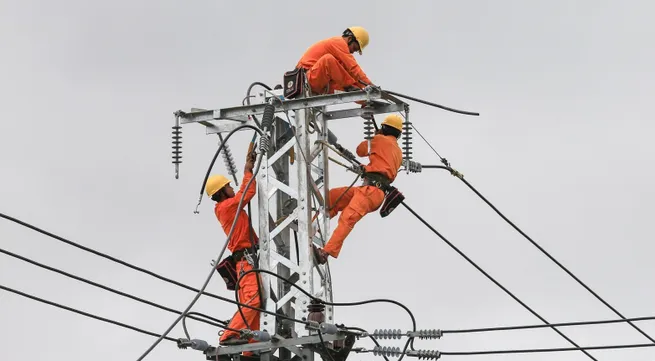Will power shortages reoccur in 2024?

Reporter: Since the beginning of the year, the electricity demand has surpassed the Ministry of Industry and Trade's forecasts and the electricity system's operational plans. In the face of numerous electricity supply production and consumption challenges, how has the Ministry of Industry and Trade mobilised alternative power sources to meet these demands? Given the actual growth in electricity consumption compared to the plan in the first months of 2024, what difficulties might the national electricity system encounter?
Mr Nguyen The Huu: The electricity load has surged by over 10% since the end of last year. In the first three months of this year, the electricity demand nationwide exceeded expectations significantly. Specifically, in the northern region, the demand for electricity within the national and local power systems has escalated by about 11% over the past four months. This figure is expected to reach 13% from May to July, marking the highest rate recorded since 2018.
Against this backdrop, at the end of 2023, the Ministry of Industry and Trade devised a flexible, tailor-made plan to ensure the electricity network could cope during the 2024 peak period. Consequently, all available power sources have been utilised to meet the rising electricity demand. The National Load Dispatch Centre (A0) has strategically employed thermal power and renewable energy sources. Estimates indicate that renewable energy can contribute up to 16% of the required output, while coal thermal power accounts for about 60%, with hydropower taking up only 12% recently. Notably, hydroelectric reservoirs have been maintained at high water levels and operated to conserve water reserves for dry season electricity peaks in 2024.
Furthermore, the Ministry of Industry and Trade has increased electricity imports from Laos. As a result, the electricity supply for commercial and domestic needs has been addressed, including during recent holidays and New Year festivities.
This year's hot weather is forecast to arrive earlier and break many temperature records. How will this situation affect the electricity network? Will the electricity shortages of 2023 be repeated during the peak dry season in 2024?
We all know that in recent times, hot weather has arrived very early in the southern region. According to the National Centre for Hydrometeorological Forecasting, the high temperatures may last until the end of May. Meanwhile, the northern region is beginning to feel the onset of its first heat waves. The peak heat period is expected to occur in May and June, leading to a surge in electricity demand.
The Ministry of Industry and Trade has issued directives for electricity units and corporations like EVN, TKV, and PVN to coordinate closely with thermal power plant investors. The aim is to ensure an uninterrupted fuel supply (coal, gas, oil) with suitable backups for electricity generation and swift troubleshooting measures. Specifically, the Ministry has instructed EVN to prepare generating units and transmission lines to meet the heightened electricity demand during the peak season.
By the end of April, based on EVN's current outlook, the Ministry of Industry and Trade revised the 2024 electricity supply and regulation plan for the peak months from May to July 2024 to better reflect the forecasted demands. This adjustment aims to maintain a nationwide electricity balance. However, in practice, there remains an element of risk, especially if the heat persists for an extended period, leading to further spikes in load or problems in large power plants. Such incidents are likely to impact the capacity balance in the northern region.
It is hoped that widespread peak season blackouts can be avoided due to the solutions devised by the State agencies and electricity suppliers and the efforts of businesses and the public to save energy and lessen the burden.
Electricity supply problems have existed for many years and still cause headaches for managers and experts. Could you please tell us how the Ministry of Industry and Trade plans to ensure an effective electricity supply in the long term?
In the long term, the Prime Minister and the Ministry of Industry and Trade will accelerate progress on power source and grid projects to enhance electricity supply capacity. The Ministry of Industry and Trade will also research and advise on policies for developing local power sources, including community-led solutions. Moreover, the Ministry will identify effective solutions from past experiences and encourage their implementation across the electricity generation and distribution network to achieve better outcomes.
The Ministry of Industry and Trade is anticipated to instruct EVN and relevant units to devise an early operation plan for 2025 by the end of this year. This proactive approach aims to get preparations underway from the third quarter of 2024 to ensure an uninterrupted electricity supply next year.
Thank you, Sir!
|
According to the Decision on the electricity supply plan for 2024, the Ministry of Industry and Trade has revised the backup electricity for 2024 and the dry season (April to July 2024) to 111.468 billion kWh. This uptick reflects an increase of 2.3 billion kWh/year compared to the previous backup plan. The Ministry requires EVN to publish updated electricity supply plans for the peak dry season months and the whole of 2024 to give power plants and the wider network time to tweak their operations accordingly. EVN must also report to the Ministry of Industry and Trade adjustments in load or power sources in the event of large fluctuations in load or power supplies. Specifically, EVN must closely monitor power plant operations to prevent avoidable outages and minimise power generation issues. |





